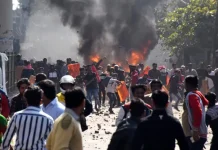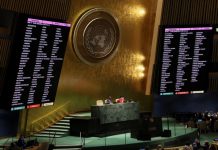
La Paz: In the capital of the South American nation, Luis Arce of the Movimiento al Socialismo (MAS [Movement for Socialism]) made a victory speech in a late-night broadcast. “We have reclaimed democracy, and above all, we have reclaimed hope,” said the 57-year-old former Finance Minister, widely known as Lucho.
The presidential election of Bolivia is a turning point in the nation’s recent history. This election had been postponed twice after the controversial poll of 20th October 2019, that brought the country into heightened political tensions.
The official results are yet to be announced on next week Monday afternoon, but exit polls clearly projected that Luis Arce had secured more than 50% of the vote while his closest contender, the centrist former president Carlos Mesa, received about 30%.

Background
The election comes after a very controversial period in Bolivia’s history. After the 2019 election Evo Morales was declared the winner, who had been the President of the nation since 2006, granting him a fourth term.
Morales was first elected as Bolivia’s president in a 2006 landslide victory, the first indigenous person to hold that office, in what is known as the ‘Pink Tide’ of South America; a series of elections that demonstrated a shift towards socialism in Latin America. Like fellow socialist Hugo Chávez in Venezuela, Morales re-wrote the constitution and then ran again under the new charter.
The first two terms of Morales saw a drastic economic growth and redistribution of wealth. From 2006, the year he took office, through 2018, GDP growth averaged 4.9%, according to World Bank data. Annual inflation, meanwhile, averaged 5.5%. Accumulated international reserves reached $15 billion (or close to 50% of GDP) in 2014. Furthermore, the percentage of people living in poverty declined from 59.6% in 2005 to 36.4% in 2017, and inequality measured by the Gini index fell from 58.5 to 44.0.
In the last three years, the government began several programs targeted at the poorest Bolivians. These include payments to low-income families to increase school enrollment, expansion of public pensions to relieve extreme poverty among the elderly, payments for uninsured mothers to expand prenatal and post-natal care, to reduce infant and child mortality. His terms saw progress for women not only in terms of welfare and poverty alleviation but also in access to positions of power. His second cabinet (2009-14) had 50% women, a first in Bolivian history.
However, the new constitution restricted access to the presidency by a two-term clause; no one was allowed to hold the office thrice. Morales approached the constitutional court and successfully obtained a ruling from the Constitutional Court that enabled him to extend his presidency because his first term occurred under the old constitution. Hence he had legally only served as President once under the new constitution.
Despite his re-election and the growing economy he created, Morales’s began to lose some of his support in the middle of his third term against the backdrop of a corruption scandal and accusations of creeping authoritarianism. As a result, voters narrowly defeated a referendum in 2016 that would have allowed him to seek re-election for a third time. Yet his Movement Toward Socialism (MAS) party nominated him anyway, and the same Constitutional Court ruled that term limits infringed on his fundamental right to run for office—a decision that set the stage for a contentious contest on October 20.
October General Election
The Bolivian constitution has a ten-per cent margin rule, the first past the poll needs at least a 10% margin to claim victory. A smaller margin automatically sets off a second round of election between the top two candidates. This details became central to the Bolivian election and claims of manipulation and rigging.
On the night of the election, Morales claimed a first-round win before the quick count, and official tallies were computed. Before the quick count advanced beyond 83%, internet service failed in the centre where it was being tabulated. The Organisation of American States (OAS) observers noted the interruption and reported it to the media. The outage lasted approximately 18 hours and blocked access to the server used to verify tally sheet data. After the blackout, the figures showed that Morales bagged a slim victory with a margin of just over 10%.
Aftermath
European Union delegations met with Morales, and the government opened the election to an inquiry. Irregularities were found in the investigation by a third-party organisation (OSA); online server counting the election results might have been manipulated by an outside server. The OAS statement said that it could not verify the result of the election. Backing away from his victory claim, President Morales called for new general elections and a new electoral tribunal but did not say if he would run again. The announcement failed to pacify the opposition, and on 10th November 2019, after 19 days of civil protests, the military and the police of Bolivia forced president Morales to resign.
Morales complied, accompanied by other resignations by high-level politicians throughout the day, some citing fears for the safety of their families. The government of Mexico offered political asylum to Morales the following day, which Morales accepted a day afterwards.
Vice President Alvaro García Linera followed suit, as did the Senate president and first vice president, Chamber of Deputies president and president of the Supreme Court—all of them in the line of succession. On November 11, a Mexican Air Force jet flew Morales, García Linera and former Health Minister Ariana Campero to Mexico where they received asylum.
In the resulting power vacuum, the Senate’s Second Vice President Jeanine Áñez from the opposition Democratic Social Movement party declared herself interim president during a legislative session on November 12 that was boycotted by MAS lawmakers. Bolivia’s Constitutional Court upheld her assumption of leadership, however temporary, as the Bolivian constitution states that new elections must be held within 90 days.
After that the election was postponed twice, granting an extension to Áñez and has finally been held.
How does the result clear up the fog?
The world was divided whether this was a revolution of the Bolivian people or was the socialist leader a victim of a coup. The United States of America has a long history of meddling in South American politics to overthrow socialist and leftist governments, particularly when they try to nationalise mineral resources and redistribute land to indigenous populations —which constitute 62% of the Bolivian population based on self-identification— all things that Morales did. The list for America toppling governments in South America is a very long one including Argentina, Bolivia, Brazil, Venezuela (thrice), Cuba, Chile, Guatemala and others.
Bolivia has huge lithium reserves, a mineral used in batteries. The ousted President claims that the USA conspired against his government and funded the opposition (which consisted largely of a white-Christian vote bank as opposed to Morales’s indigenous vote bank) to gain access to the reserves. Interestingly, as a result of the US-China trade war, China has gained disproportionate access to world lithium reserves leaving the USA bereft of access and hence a limited production capacity of phones and electronics that use a battery.
The re-election of the MAS has put a question mark on the credibility of the “mass protests”. Morales’s party has sprung up with an even larger margin to the presidency for a fourth consecutive term. Possibly the first in Latin American history to undo a coup.








